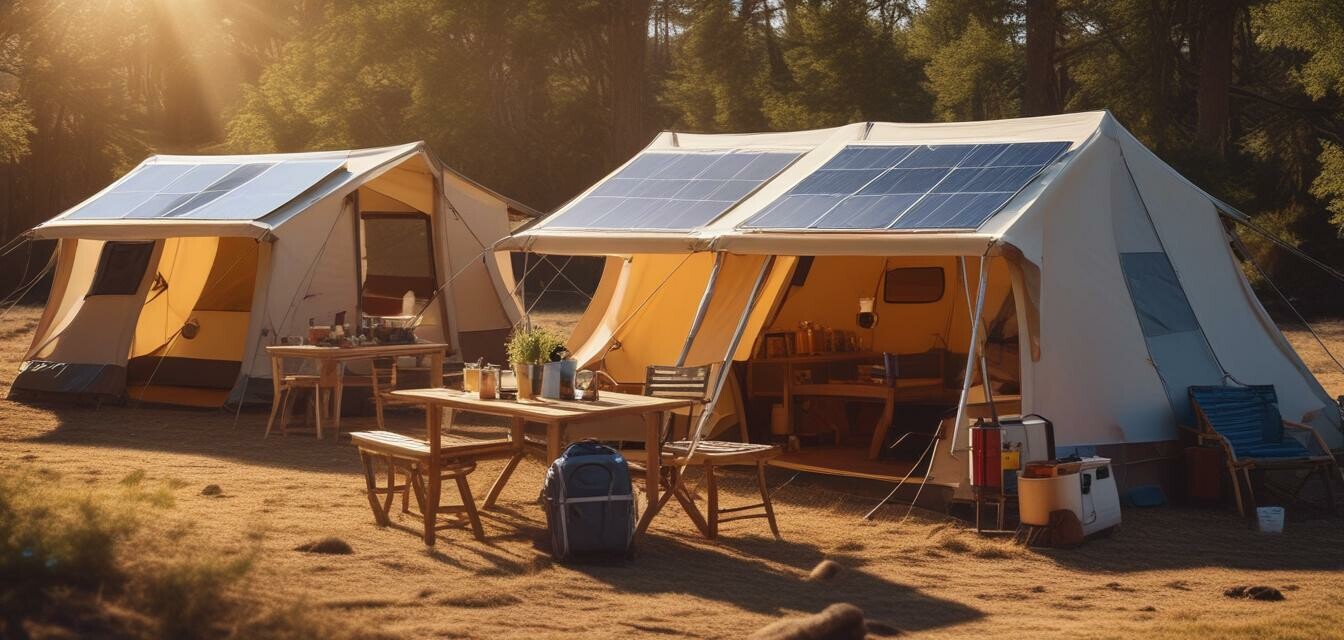
Prep your campsite: Setting up your solar equipment
Key takeaways
- Understand the importance of solar energy in camping.
- Learn how to position solar panels for maximum sunlight.
- Know the essential equipment for solar setup.
- Get tips on maintaining your solar system while camping.
- Explore different solar-powered camping shelters.
Camping in the great outdoors is an exhilarating experience, and with the advent of solar technology, you can enhance it even further. Setting up your solar equipment properly at your campsite ensures optimal energy usage, allowing you to power your gadgets, lights, and even small appliances effectively. In this guide, we'll walk you through the essential steps to set up your solar equipment and maximize your energy efficiency during your camping adventure.
Why use solar equipment while camping?
Using solar power at your campsite provides numerous benefits, including:
- Eco-friendly energy source: Solar energy is renewable and reduces your carbon footprint.
- Independence from traditional power sources: You can enjoy your camping experience without the need for outlets or generators.
- Cost-effective in the long run: After the initial investment, you'll save money on fuel and batteries.
Essential solar equipment for your campsite
Before heading out on your camping trip, make sure you have the following essential solar equipment:
| Equipment | Description |
|---|---|
| Solar panels | Generate electricity from sunlight to power your devices. |
| Solar inverter | Converts the DC electricity generated by solar panels into AC for your appliances. |
| Battery storage | Stores excess energy for use during low sunlight conditions. |
| Charge controllers | Regulates voltage and current from the solar panels to prevent damage to batteries. |
| Solar lights | Provide illumination for your campsite using stored solar energy. |
Steps to set up your solar equipment at the campsite
Setting up your solar equipment is a straightforward process. Follow these steps to ensure everything is configured correctly:
Step 1: Choose a suitable location
Select a spot that receives ample sunlight without obstruction. Here are some tips:
- Avoid shadows from trees, rocks, or tall equipment.
- Pay attention to the sun's path and time of day.
- Ensure your solar panels are safely secured to prevent tipping.
Step 2: Assemble the solar panels
Set up your solar panels according to the manufacturer's instructions. Generally, you'll want to:
- Unpack the solar panels and lay them flat.
- Connect the panels if you are using multiple units.
- Adjust the tilt angle for optimal sun exposure.
Step 3: Connect charge controllers and batteries
Once your panels are set up, it’s time to connect the charge controllers and batteries:
- Attach the charge controller to the solar panels using the provided wires.
- Connect the batteries to the charge controller to store the energy.
Step 4: Set up your devices
Now you can connect your appliances and devices to the inverter:
- Connect the inverter to the batteries.
- Plug your devices into the inverter's outlets.
- Check if everything is functioning properly.
Important tips for maintaining your solar setup
To ensure your solar equipment works effectively throughout your camping trip, consider these maintenance tips:
- Regularly clean your solar panels to remove dirt and debris.
- Monitor battery levels and charge controllers frequently.
- Store your equipment properly to avoid damage.
Tips for beginners
- Start small: If you're new to solar camping, begin with basic equipment.
- Practice setup at home: Before heading into the wilderness, practice your setup in your backyard.
- Research solar camping gear: Explore our buying guides for in-depth product information.
Common mistakes to avoid
While setting up your solar equipment, be aware of these common mistakes:
- Not accounting for shading during peak sunlight hours.
- Underestimating the number of batteries needed for your devices.
- Forgetting to secure your solar panels in windy conditions.
Explore more solar camping options
If you're looking to expand your solar camping gear, check out these related articles:
- Solar camping tents offer power and shelter in one.
- Solar lanterns & lights provide illumination without batteries.
- Solar cookers & grills let you prepare meals using sunlight.
Pros
- Environmentally friendly energy source.
- Reduces the need for fuel.
- Enhances the camping experience by providing comfort.
Cons
- Initial investment can be higher than traditional camping gear.
- Performance can be affected by weather conditions.
- Requires regular maintenance for optimal efficiency.
Conclusion
Setting up solar equipment at your campsite not only boosts your energy options but also enhances your overall camping experience. By following the steps laid out in this guide and utilizing the tips for maintenance and setup, you'll be well on your way to a successful solar-powered adventure. Remember to check our Expert Tips for more insights on maximizing solar energy while camping!